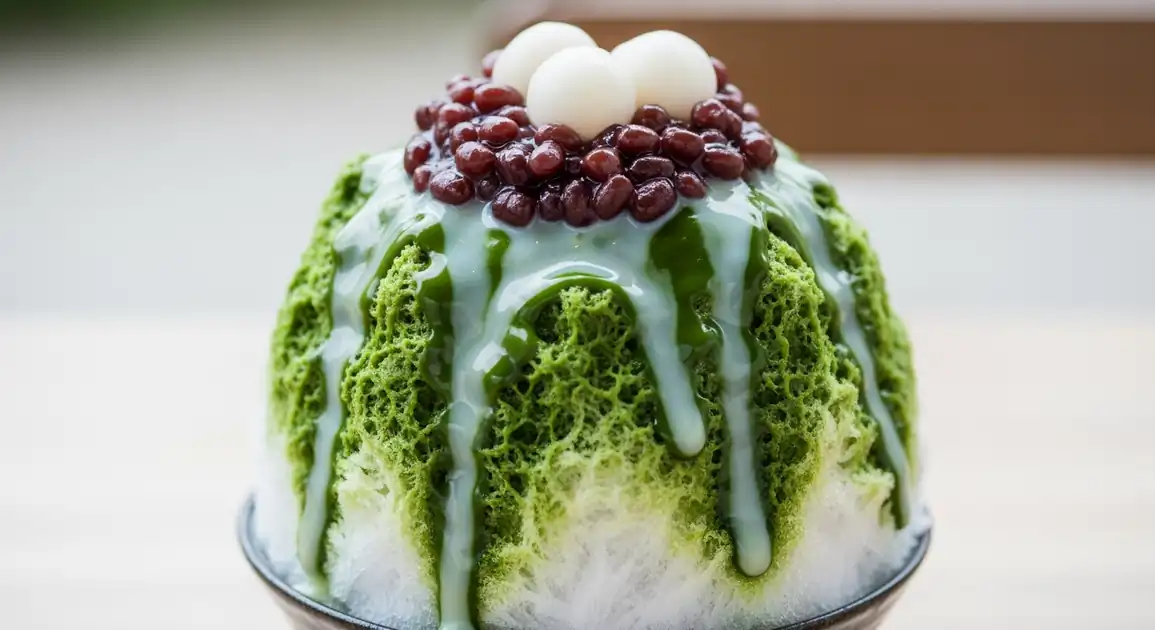Kakigori (Japanese Shaved Ice)
かき氷

Description
Kakigori is a ubiquitous summer dessert across Japan, found everywhere from bustling summer festivals ('natsumatsuri') to serene traditional tea houses and trendy specialty cafes. It's deeply associated with surviving the hot and humid Japanese summers.
Dietary Information
Serving information
Serving style
Served in a bowl (plastic, paper, or ceramic) with a spoon. Often identified by a flag with the character '氷' (kōri).
Quick facts
Highly variable. Festival stalls: Evenings. Cafes/Shops: Typically daytime/afternoon (e.g., 11 AM - 6 PM), some later. Peak summer season.
Safety Tips
What to Look For
-
Extremely fine, fluffy ice texture
This indicates a quality shaving machine and proper technique, core to the Kakigori experience. Avoid coarse, chunky ice.
-
Cleanliness of the vendor/shop and machine
Japan generally has high hygiene standards, but always check that the machine, utensils, and serving area look clean.
-
Natural-looking syrups (especially in specialty shops)
While artificial syrups are common at festivals, specialty shops often use house-made or natural fruit syrups, indicating higher quality ingredients.
-
Use of clear, solid ice blocks
Good quality ice is the foundation. Some shops pride themselves on using specific types of pure or natural ice.
-
High turnover (especially at festivals)
Busy stalls mean the product is likely fresh and hasn't been sitting around, though Kakigori is always made to order.
What to avoid
-
Coarsely crushed or granular ice
This isn't true Kakigori texture and suggests a lower quality machine or different type of dessert.
-
Visibly dirty machine or serving area
Basic hygiene is essential, even for a simple dessert like shaved ice.
-
Syrups that look overly artificial or toppings that appear old
Opt for fresh-looking ingredients. While bright colors are common, excessively neon syrups might be lower quality.
-
Stagnant or dirty water visible near the preparation area
Clean water handling is important, although mains water in Japan is generally very safe.
Price information
Price range
Budget tips
- Festival stalls offer the most basic and cheapest versions (300-600 JPY).
- Convenience stores sometimes sell simple pre-packaged versions.
- Look for local 'kissaten' (old-style cafes) for reasonably priced traditional flavors.
Value indicators
- Fluffy, finely shaved ice texture.
- Generous amount of syrup and toppings.
- Use of house-made syrups or 'tennen-gōri' (natural ice) indicates premium quality (and higher price).
- Served quickly after ordering.
Where to Find This Dish
Summer Festivals ('Natsumatsuri')
Found at countless local festivals nationwide.
Shrines, Temples, Parks hosting events
Evenings during festival dates
Traditional Shopping Streets ('Shotengai')
Local cafes or sweet shops along these streets often serve it.
Local neighborhood shopping arcades
Daytime, Afternoon
Beach Areas ('Umi no Ie')
Beach huts commonly sell basic flavors.
Popular beaches
Daytime during beach season
Department Stores ('Depachika')
High-end food halls sometimes have pop-up or permanent stalls.
Basement food floors of major department stores
Store hours
Vendor Tips
- Look for the '氷' flag indicating shaved ice is sold.
- Specialty shops often have queues, especially famous ones.
- Don't be afraid to try unique seasonal fruit flavors.
How to Order
Regional Variations
-
Ichigo Milk
(いちごミルク)
Classic combination of strawberry syrup ('ichigo') generously drizzled with sweetened condensed milk ('milk'/'rennyū').
-
Uji Kintoki
(宇治金時)
A traditional favorite featuring rich matcha (green tea) syrup from Uji, topped with sweet azuki red bean paste ('kintoki'/'anko'), often includes shiratama dango (mochi balls).
-
Kuromitsu Kinako
(黒蜜きなこ)
Flavored with 'kuromitsu' (Japanese brown sugar syrup) and dusted with 'kinako' (roasted soybean flour), offering a nutty, molasses-like flavor. Often served with mochi.
-
Shirokuma
(白熊)
Originating from Kagoshima, this 'polar bear' Kakigori features condensed milk syrup decorated with various fruits (like oranges, cherries, pineapple) and sweet beans, arranged to resemble a bear's face.
-
Fruit Kakigori
(フルーツかき氷)
Modern variations often feature elaborate fresh fruit purees or chunks as syrups and toppings, like mango, peach, or mixed berries.
-
Simple Syrup Flavors
((e.g., メロン, レモン))
Basic, often brightly colored syrups like Melon, Lemon, Blue Hawaii, Calpis (a yogurt-like drink flavor). Common at festivals and beaches.
Cultural context
History
The origins of Kakigori trace back to the Heian period (794-1185), where ice was shaved with a knife and served with sweet saps to the aristocracy. It became more accessible in the Meiji period (19th century) with the advent of ice machines. Today, Kakigori is a beloved summer staple enjoyed by everyone, evolving from simple festival fare to elaborate gourmet creations in specialty shops, symbolizing the refreshing relief from Japan's summer heat.
Local significance
A quintessential symbol of Japanese summer, offering refreshment and nostalgia. Enjoying Kakigori is a cultural ritual during the hot months.
Eating customs
- Eat quickly before it melts.
- Using the provided spoon.
- It's acceptable and expected for some ice to melt into a sweet soup at the bottom of the bowl.